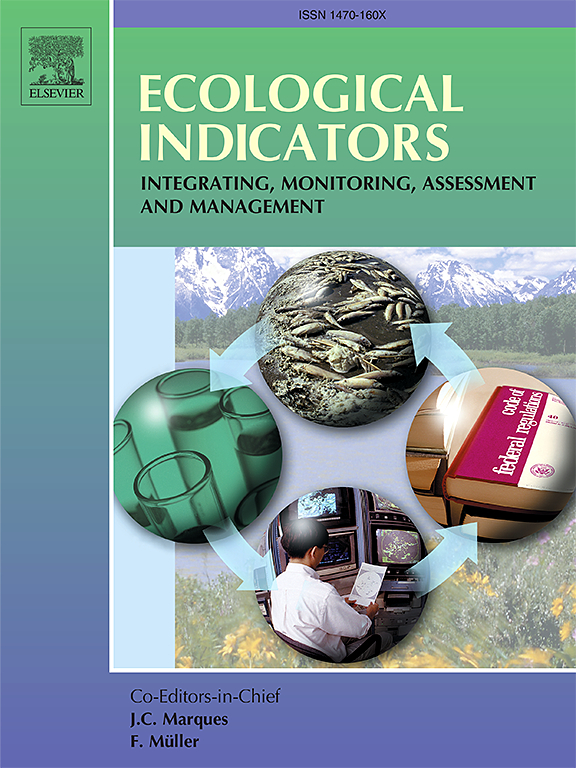Lepidoptera abundance and diversity as a quantitative measure of ecosystem function in bioretention design
IF 7
2区 环境科学与生态学
Q1 ENVIRONMENTAL SCIENCES
引用次数: 0
Abstract
The choices of engineers and other professionals working in urban environments can either mitigate or exacerbate drivers of ecosystem and biodiversity decline. To date, engineers designing bioretention basins for management of urban surface runoff typically have not considered implications of their design and management decisions on terrestrial ecosystem structure and function. However, a foundation of knowledge sufficient to evaluate design decisions in light of ecosystem functions exists in the fields of engineering and ecology, and this knowledge can be connected to improve design outcomes. Bioretention system functions considered in this paper are hydrologic regulation, production, nutrient retention, and habitat provisioning. We 1) review existing knowledge on the use of quantitative criteria to advance terrestrial ecosystem objectives in bioretention design, with a focus on Lepidoptera abundance and diversity as a proxy for these ecosystem functions, 2) report results of a literature review identifying gaps in knowledge and interdisciplinary communication limiting achievement of terrestrial ecosystem objectives, and 3) connect existing data and literature across disciplines to propose a novel design and plant choice approach to fill these gaps. A key criterion recommended as a proxy for terrestrial ecosystem function in bioretention basins is the number of Lepidoptera species supported in the larval stage by the plant genera selected by the designer. Designers can adjust plant choice to maximize this value, subject to tradeoffs with other design objectives and site-specific constraints. We conclude by presenting a set of questions to guide future research and providing recommendations for translating research findings into professional practice.
鳞翅目丰度和多样性作为生物保留设计中生态系统功能的定量度量
在城市环境中工作的工程师和其他专业人员的选择可以减轻或加剧生态系统和生物多样性下降的驱动因素。迄今为止,设计用于管理城市地表径流的生物截留盆地的工程师通常没有考虑其设计和管理决策对陆地生态系统结构和功能的影响。然而,在工程和生态学领域存在足够的知识基础,可以根据生态系统功能来评估设计决策,并且可以将这些知识连接起来以改善设计结果。本文考虑的生物滞留系统功能包括水文调节、生产、养分保留和生境供应。我们1)回顾了利用定量标准推进陆地生态系统生物保留设计目标的现有知识,重点关注鳞翅目丰度和多样性作为这些生态系统功能的代表;2)报告了文献综述的结果,指出了限制陆地生态系统目标实现的知识差距和跨学科交流;3)将现有的数据和跨学科的文献联系起来,提出一种新的设计和植物选择方法来填补这些空白。作为生物保留盆地陆地生态系统功能的一个重要指标,是设计者选择的植物属在幼虫期支持的鳞翅目物种数量。设计师可以调整植物的选择,以最大限度地提高这一价值,但要与其他设计目标和特定场地的限制进行权衡。最后,我们提出了一系列问题来指导未来的研究,并为将研究成果转化为专业实践提供了建议。
本文章由计算机程序翻译,如有差异,请以英文原文为准。
求助全文
约1分钟内获得全文
求助全文
来源期刊

Ecological Indicators
环境科学-环境科学
CiteScore
11.80
自引率
8.70%
发文量
1163
审稿时长
78 days
期刊介绍:
The ultimate aim of Ecological Indicators is to integrate the monitoring and assessment of ecological and environmental indicators with management practices. The journal provides a forum for the discussion of the applied scientific development and review of traditional indicator approaches as well as for theoretical, modelling and quantitative applications such as index development. Research into the following areas will be published.
• All aspects of ecological and environmental indicators and indices.
• New indicators, and new approaches and methods for indicator development, testing and use.
• Development and modelling of indices, e.g. application of indicator suites across multiple scales and resources.
• Analysis and research of resource, system- and scale-specific indicators.
• Methods for integration of social and other valuation metrics for the production of scientifically rigorous and politically-relevant assessments using indicator-based monitoring and assessment programs.
• How research indicators can be transformed into direct application for management purposes.
• Broader assessment objectives and methods, e.g. biodiversity, biological integrity, and sustainability, through the use of indicators.
• Resource-specific indicators such as landscape, agroecosystems, forests, wetlands, etc.
 求助内容:
求助内容: 应助结果提醒方式:
应助结果提醒方式:


